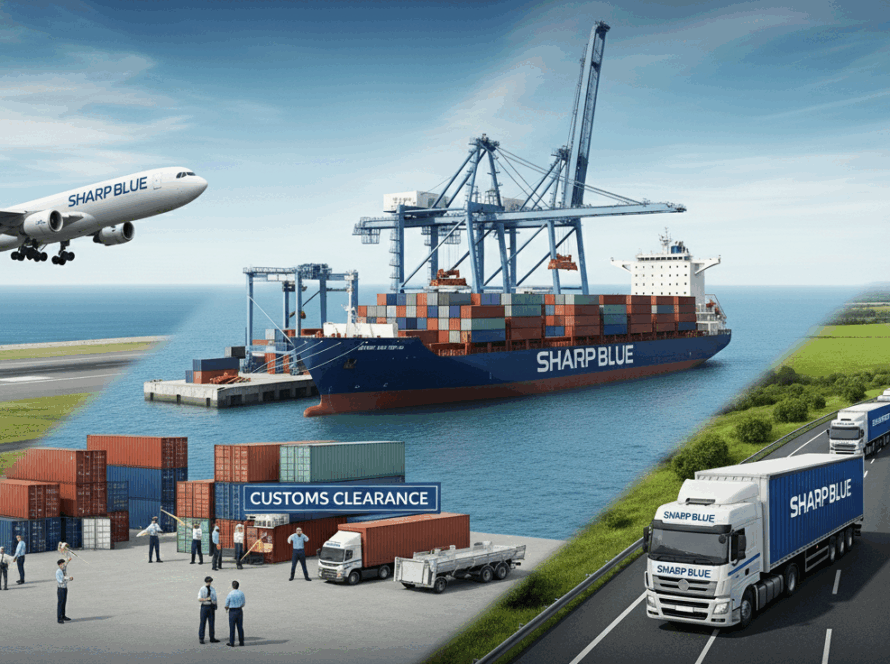In the world of eCommerce logistics isn’t just a back-end operation — it’s the behind the scenes engine that drives customer satisfaction, brand reputation and profitability. But for new and growing businesses navigating logistics can feel overwhelming. From managing stock to delivering the final package, every step counts. So how do you ship smarter, not harder?
Let’s get into the world of eCommerce logistics, the essentials, strategies and smarter shipping solutions that help businesses grow faster and stronger.
At Sharp Blue we simplify logistics for businesses ready to scale. In this blog we break down everything you need to know about mastering eCommerce logistics — and how working with us can set your business up for long term success.
Understanding eCommerce Logistics
At its simplest eCommerce logistics is storing, picking, packing, shipping and delivering products ordered online. It’s managing inventory, processing orders, fulfilling deliveries, handling returns and making sure customers get their products quickly.
In short:
Logistics is everything that happens between “Buy Now” and “Order Delivered.”
But here’s the thing: in today’s eCommerce world speed, accuracy and experience matter just as much as the product itself. 84% of online shoppers say delivery impacts their loyalty to a brand.
So, logistics isn’t optional — it’s a business-critical function.
The Key Components of eCommerce Logistics
To ship smarter, you need to understand the foundations of eCommerce logistics:
-
Inventory Management:
Before a product can be delivered to a customer, it must first be available in inventory. Smart inventory management means knowing what to stock, how much to stock, and where to stock it.
A study by IHL Group found that out-of-stocks cost retailers nearly $1 trillion annually.
For growing businesses implementing real-time inventory tracking systems — even simple ones at the start — can prevent lost sales and overstock costs.
-
Order Fulfillment:
Order fulfillment is everything from receiving the online order to getting the product ready to ship.
This includes:
• Picking items from warehouse shelves
• Packing them securely
• Preparing shipping labels
Businesses need to streamline fulfillment to minimize errors and speed up dispatch because the clock starts ticking the moment a customer places an order.
-
Shipping and Delivery:
Choosing the right shipping partners and methods directly impacts delivery times, costs, and customer satisfaction.
Smart strategies involve:
• Multi-carrier shipping (not relying on just one courier)
• Choosing regional warehouses closer to customers
• Offering multiple delivery options (express, standard, pickup points)
A survey found that 21% of online shoppers abandon purchases if delivery options are limited or slow.
-
Return Management:
Returns are inevitable in eCommerce — especially in fashion, electronics, and beauty sectors.
A good logistics system makes returns:
• Easy for customers
• Efficient for the company
• Not a profitability killer
Fact: 92% of customers say they will buy again if the returns process is easy.
Common eCommerce Logistics Challenges
Here are some common hurdles:
- Inventory Visibility Issues: Lack of real-time data leads to overselling or stock outs.
- Shipping Delays: Weather, customs, or carrier problems can disrupt deliveries.
- High Shipping Costs: Poorly negotiated carrier rates eat into margins.
- Scaling Difficulties: Sudden growth without logistics infrastructure causes operational bottlenecks.
- International Complexities: Tariffs, taxes, and customs regulations vary by country.
How eCommerce Logistics Works: Step-by-Step
Understanding the flow of eCommerce logistics empowers you to make smarter decisions and deliver a better customer experience. Here’s a clear breakdown of the essential steps:
-
Receiving Inventory:
Your products first arrive from suppliers or manufacturers to your warehouse or fulfillment center. This step involves verifying the quality and quantity of goods received, inspecting for damage, and updating inventory records to account for all that accurately.
-
Inventory Storage:
After inspection, Products are orderly placed after inspection in the storage facility. Products are grouped together, identified (most commonly by barcodes or SKUs), and placed in a manner to facilitate quick picking. Effective storage conserves handling time and reduces mistakes in order fulfillment.
-
Order Placement:
Customers go to online shop or marketplace and place an order. Once an order is confirmed, it triggers the next steps in the fulfillment process automatically. Well integrated systems offer smooth order flow in real time into warehouse operations without the need for human involvement.
-
Order Processing:
When order notifications come into the fulfilment center, the fulfilment team will pick the ordered items from storage and check all items to ensure accuracy prior to packaging. Packaging is equally as important as the other steps — packing goods properly protects the product while in transit, ensures the smallest shipping cost, and helps provide a great unboxing experience for the customer.
-
Shipping:
When packed, the order is shipped to the carrier, such as FedEx, DHL, Australia Post or any other logistics provider you choose like Sharp Blue. Then, the carrier will take it to the customers. It is important to choose the right carrier and shipment speed so that customer delivery expectations are met and overall costs are managed.
-
Delivery Tracking:
Customers expect visibility on their orders. Real-time tracking systems allow you and your customers to track their delivery from the moment the order is packed and handed to the carrier until it is placed on their doorstep. Timely, proactive tracking information helps build consumer trust and can be used to assist customers if deliveries have not arrived, or missed their delivery window.
-
Returns (Reverse Logistics):
Not every order may be the end of a transaction. When customers proactively reach out to you regarding a return or exchange, the returned product will need to be inspected, verified and received into stock or disposed of. A well-functioning reverse logistics is a critical component of order fulfillment and maintaining satisfied customers who will continue shopping with you.
Types of eCommerce Logistics Models
The correct logistics model must be chosen in order to improve efficiency, control costs, and facilitate great customer satisfaction. The best model is dependent on your business size, range of products, target markets and future growth plans. Below is a summary of the most recognized eCommerce logistics models:
-
In-House Fulfillment:
Under the in-house fulfillment model, you manage the entire fulfillment process in-house. You manage everything from receiving inventory and stocking inventory, picking, packing and shipping the orders. You fully control the fulfillment, which means you can personalize packing and tighten quality control.
Best suited for:
• Startups and small businesses with an order volume they can easily manage.
• Brands that offer niche or high-value products that require more protection.
Challenges:
• Maintaining warehouses, employees and technology will become costly and overwhelming as order volume increases. Scaling, without dedicated money, will quickly become a strategy on an operational burden. -
Third-Party Logistics (3PL) Providers:
When you use a 3PL model, you outsource your fulfillment to a 3PL provider. The 3PL provider handles your warehousing, inventory, order processing, shipping, and some returns for you.
Best suited for:
• Growing businesses with a sales and marketing focus.
Benefits:
• The ability to use scalable capabilities, logistics experience, technology integrations, and typically better shipping rates.
Sharp Blue Tip:
Working with a 3PL provider allows businesses to expand into domestic and international markets effectively without the required capital investment in warehousing, personnel, and shipping systems. -
Dropshipping:
If you choose to dropship, you are not involved at all with inventory management or shipping; instead, when a customer places an order, the product is shipped directly to the customer from your supplier or product manufacturer.
Best for:
• Any entrepreneur with limited start-up capital.
• Companies who are testing new products or markets without incurring the risk of holding inventory.
Drawbacks:
• You will have less control over inventory (if there is not enough to fulfill an order), product quality, packaging of your product, and timelines for delivery — all of which could negatively impact your customers’ experience. -
Hybrid Logistics Models:
Many companies take on hybrid approaches that integrate several distinct logistics strategies to meet different needs. For instance, you might handle local deliveries in-house to be able to ship them more quickly, but utilize an outside 3PL for international orders.
Best for:
• Rapidly growing companies in multiple geographies.
• Companies that offer a varied selection of products and have varying fulfillment needs.
Benefits:
• Ability to mix and match logistics operations as your company grows.
• Ability to get a balance between cost-effectiveness and service.
Key Strategies for Optimizing eCommerce Logistics
To improve your logistics strategies, consider the suggestions below:
-
Use Technology to Automate:
• Warehouse Management Systems: It will allow you to automate inventory tracking and order processing, which reduces chances for human error, decreases costs, and improves overall efficiency.
• Shipping Software: It can help by allowing you to integrate with your carrier to automate printing labels, tracking shipments, and optimizing routes to lessen a lot of work from employees.
• AI & Machine learning: Can be programmed to create predictive analytics from current sales and historical data to inform your warehouse inventory levels; for a company with excess inventory on a product, it can save millions of dollars.
-
Optimize Packaging:
• Eco-Friendly Materials: Using recyclable or biodegradable packaging can appeal to a growing segment of consumers.
• Right-Sizing: Packaging that fits a product will decrease shipping costs and provide less environmental impact.
• Branding: Engaging branding elements on your packaging will enhance customer experience.
-
Offer Flexible Shipping Options:
• Various Carriers: Partnering with several different carriers can provide customers options with regards to delivery speed and delivery cost.
• Local Fulfillment Centers: You will be able to improve delivery times by setting local fulfillment centers in key locations to serve certain regions instead of shipping out of one facility.
• Subscription Service: Provide a subscription-based shipping option for your frequent customers to help increase repeat store visits.
-
Adopt Sustainable Practices:
• Route Optimization: Use technology to assist with route planning to find the most efficient delivery routes so that you can reduce fuel consumption and emissions.
• Electric Vehicles: Take into consideration using electric or hybrid vehicles for last-mile deliveries to reduce your carbon footprint.
• Carbon Offsetting: Offer clients an option to offset the carbon footprint for their deliveries.
-
Improve Returns Management:
• Clear Policies: Clearly communicate your return policy on your website so the customer knows your return policy ahead of time.
• Simple Process: Make it simple for customers to return items. This helps build confidence in you & the purchasing process and helps secure repeat business.
• Reverse Logistics: Create a plan to handle all goods that are returned, including restocking the items and/or recycling them.
How Sharp Blue Supports Emerging and New eCommerce Businesses
Sharp Blue operates specifically to simplify complex logistics for small, medium, and large companies. From importing goods to Australia to international freight our tailored solutions ensure your customers enjoy smooth, fast, and reliable deliveries — stress-free.
Our services include:
• Air Freight
• Sea Freight Solutions
• Inland Transportation
• Customs Clearance and Compliance Support
Shipping smarter starts with partnering smarter. Have Sharp Blue be your logistics partner as you build your eCommerce success story.
Conclusion
Mastering eCommerce logistics is the key to winning in today’s competitive online marketplace. By understanding the logistics process, utilizing the right technologies, and constantly refining your operations, your business can stay ahead of the curve. Successful logistics mean shorter delivery times, lower costs, and higher levels of customer satisfaction—all of which translate to profits and growth. Don’t also forget that every day the business of logistics evolves. Keeping ahead of emerging trends, technologies, and best practices will keep your company vibrant and responsive to consumers’ demanding attitudes today.



